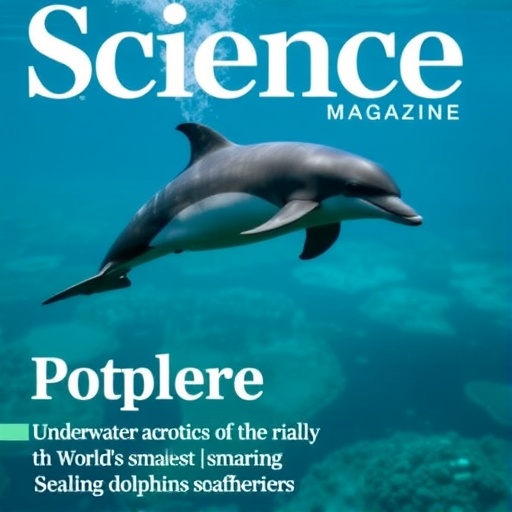In an unprecedented study combining advanced animal tracking technology and acoustic monitoring, researchers at the University of Auckland have unveiled new insights into the subsurface behaviors of Hector’s dolphins. Through meticulous data collection and real-time animations, scientists reconstructed the intricate diving patterns of these elusive creatures, revealing behaviors that could significantly influence their risk of bycatch in fishing operations. This groundbreaking research not only deepens our understanding of Hector’s dolphins’ underwater life but also highlights critical conservation challenges facing this vulnerable species.
Hector’s dolphins, known for their distinctive rounded dorsal fins and limited geographic range around New Zealand’s coastal waters, have long captivated marine biologists. However, the species’ underwater activities have remained largely concealed, complicating efforts to assess threats from human activities such as fishing bycatch. By employing sophisticated tags equipped with accelerometers, hydrophones, and GPS units, the research team captured detailed tracking information that enabled a vivid reconstruction of the dolphins’ dives.
The study’s key innovation lies in its use of an animated visualization that replays a dolphin’s dive in real time. This animation is enriched with sound cues directly recorded from the tagged animals, delivering a multisensory representation of the dolphin’s underwater world. Visual markers in the animation denote various behaviors: triangular icons signify when the dolphin surfaces, circles trace their descent and ascent, and color-coded lines represent body orientation. The blue line indicates when the dolphin is dorsal side up, while a yellow line shows moments of inverted swimming or barrel rolls, behaviors observed during shallow dives or when navigating close to the seabed during deep excursions.
Sound analysis plays a pivotal role in decoding the mysteries of the dolphins’ hunting strategies. Red starbursts flash on the animation at moments when the dolphin engages in pursuit of prey, indicated acoustically by a ‘buzz’—a rapid series of clicks used for precise echolocation targeting. These high-speed clicks contrast with the slower, rhythmic ‘click, click, click’ echolocation pulses the dolphin emits regularly to navigate its environment and locate fish. Complementing these vocalizations is a continuous ‘woosh’—the hydrodynamic sound produced as water flows over the tag during swimming, offering a realistic audio texture akin to wind passing by a cyclist.
The detailed path of the dolphin along the seabed is traced by a thin grey line within the animation, helping researchers correlate physical movement with acoustic cues and environmental context. Such integrative data categorization allows a nuanced understanding of how body orientation—whether right side up or inverted—affects foraging efficiency and maneuverability in varying depths. These subsurface behaviors are crucial for foraging success but may also inadvertently increase interactions with fishing gear, thus elevating bycatch risks.
Bycatch, the incidental capture of non-target species in fishing nets, remains one of the leading threats to Hector’s dolphin populations. The study’s findings suggest that specific diving and swimming postures, especially extended periods spent near the seabed and inverted swimming patterns, may expose dolphins to higher entanglement probabilities. Insight into these behaviors provides invaluable data for designing mitigation strategies in fisheries management, such as adjusting net placements or modifying fishing times to reduce overlaps with dolphin hotspots.
The observational research approach employed by the University of Auckland scientists signifies a milestone in marine biology, marrying behavioral ecology with state-of-the-art bio-logging technology. Unlike controlled experiments, the study monitors dolphins in their natural habitat, preserving the authenticity of their behaviors. This method yields ecologically valid data critical for formulating effective conservation policies based on realistic activity patterns rather than theoretical models.
In addition to direct conservation applications, the research offers a compelling model for studying other marine mammals whose underwater behaviors are difficult to observe. The integration of movement data with acoustic signatures sets a new standard for non-invasive, high-resolution behavioral studies, potentially applicable to species worldwide confronting similar risks. Future projects could expand this framework to investigate social interactions, breeding behaviors, and responses to environmental changes.
The implications of this work resonate beyond scientific circles, bearing significance for policy-makers, fishery operators, and conservationists striving to safeguard marine biodiversity. As Hector’s dolphins are emblematic of New Zealand’s unique marine heritage, preserving their habitats and reducing human-induced mortality align with global biodiversity commitments and national ecological stewardship.
The University of Auckland team’s novel visualization transcends traditional scientific reporting. By offering an immersive window into the dolphin’s experience—complete with realistic soundscapes and dynamic movement—the study fosters public engagement and awareness. Such compelling portrayals are key to galvanizing support for marine conservation initiatives, bridging the gap between complex research and the broader public’s understanding.
This research, published in Conservation Letters, marks a critical step forward in unraveling how underwater behavior influences vulnerability to anthropogenic threats. Continued advancements in acoustic and movement monitoring promise to refine our grasp of cetacean ecology, enabling more targeted interventions that can ensure the survival of Hector’s dolphins amid mounting environmental pressures.
As marine ecosystems grapple with rapid changes induced by climate shifts and human exploitation, studies like this underscore the necessity of blending technological innovation with ecological sensitivity. The nuanced behavioral insights gleaned here pave the way for adaptive management that respects both the biological intricacies of marine life and the socio-economic realities of coastal communities.
Ultimately, the success of conservation efforts hinges on transforming detailed scientific knowledge into practical solutions. The revelations about Hector’s dolphins’ subsurface behaviors exemplify how cutting-edge research can pinpoint critical vulnerabilities, guiding collaborative efforts to minimize bycatch, foster sustainable fisheries, and preserve the delicate balance of marine ecosystems.
Subject of Research: Animals
Article Title: Subsurface Behaviors of Hector’s Dolphins Could Increase Their Risk of Bycatch
News Publication Date: 14-Sep-2025
Web References: http://dx.doi.org/10.1111/conl.13144
Image Credits: University of Auckland
Keywords: Hector’s dolphins, bycatch, echolocation, subsurface behavior, marine conservation, bio-logging, acoustic monitoring, animal tracking, marine mammals, behavioral ecology
Tags: acoustic monitoringadvanced research methodsanimal tracking technologybycatch risk assessmentdolphin diving patternsHector’s dolphinsmarine conservation challengesmultisensory representationNew Zealand coastal watersscience magazine featuresunderwater acrobaticsvulnerable marine species





